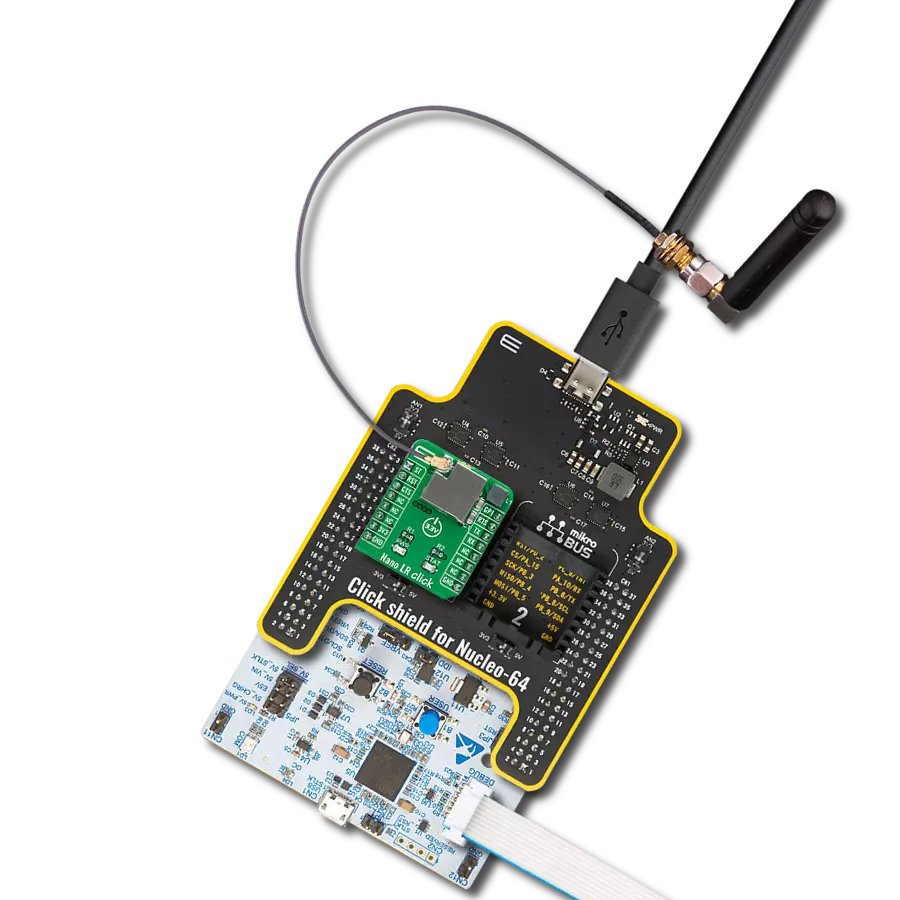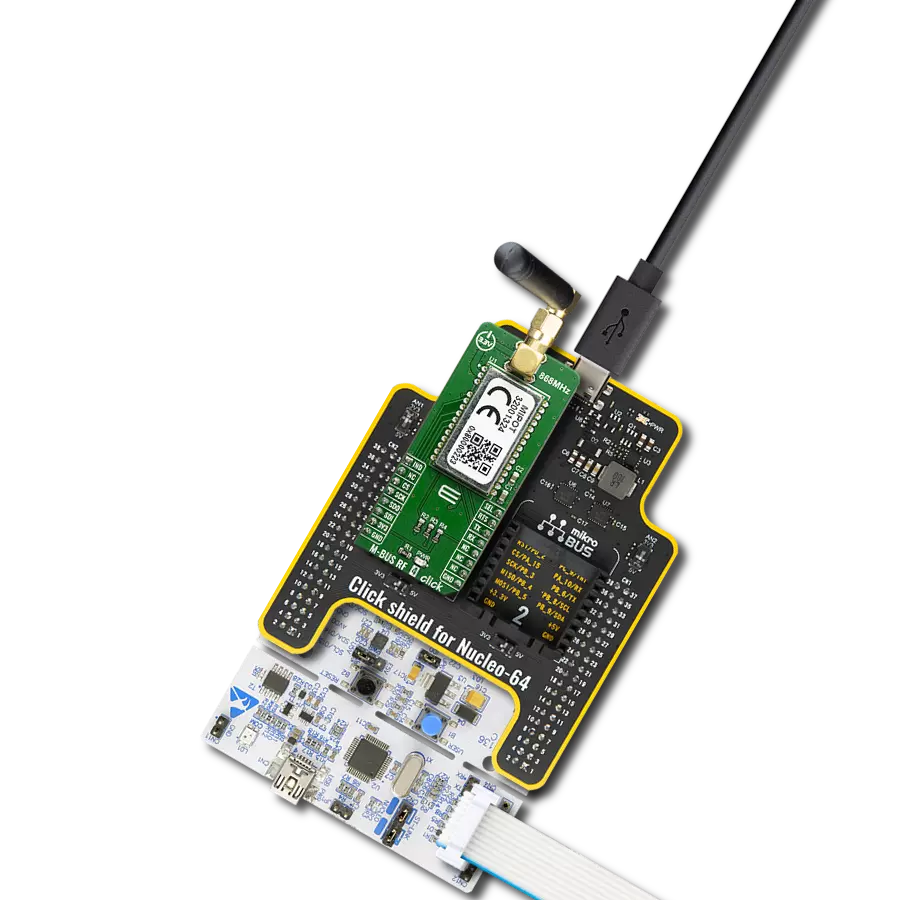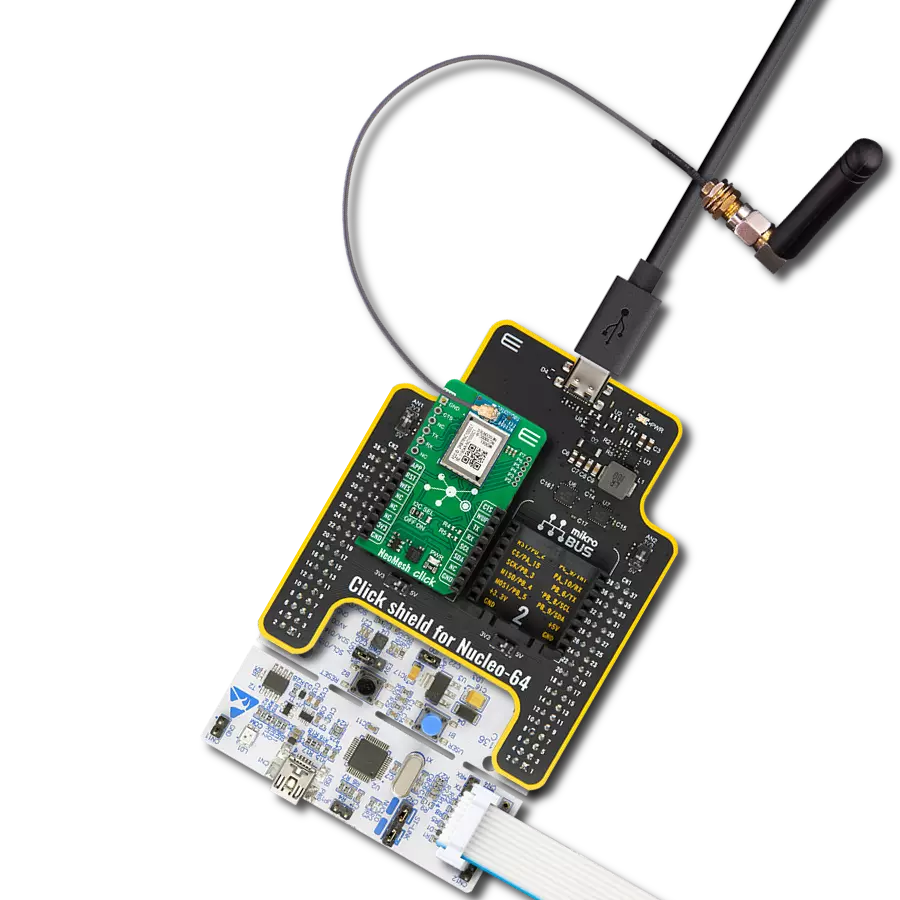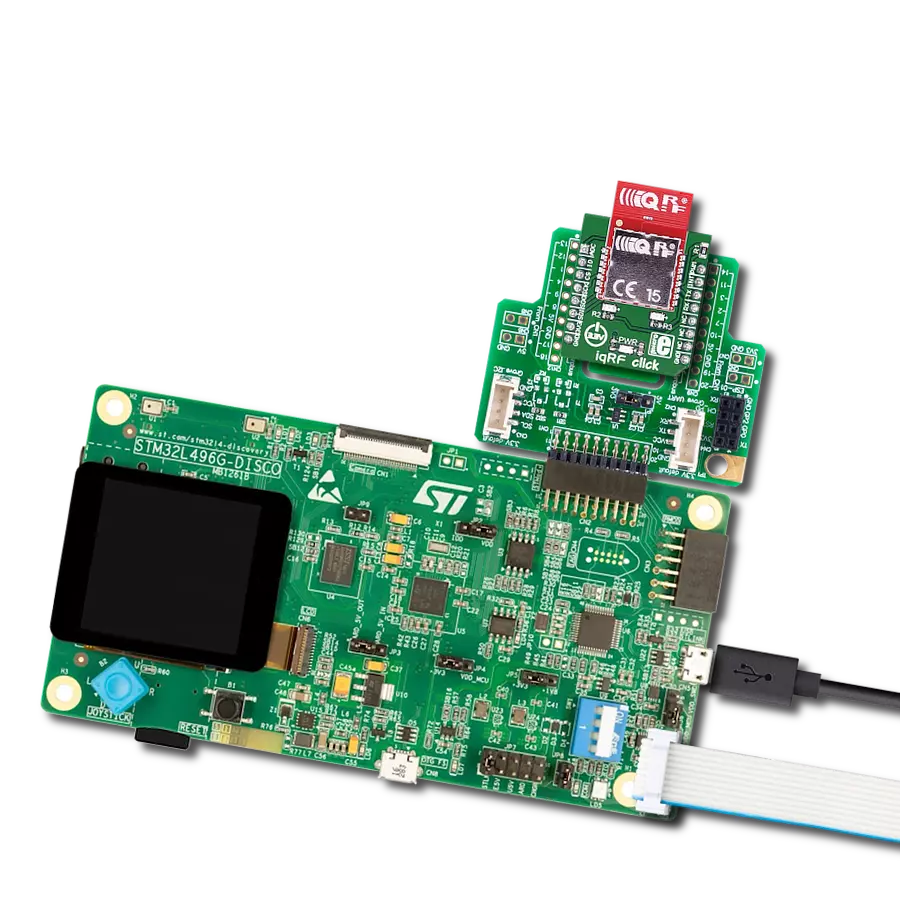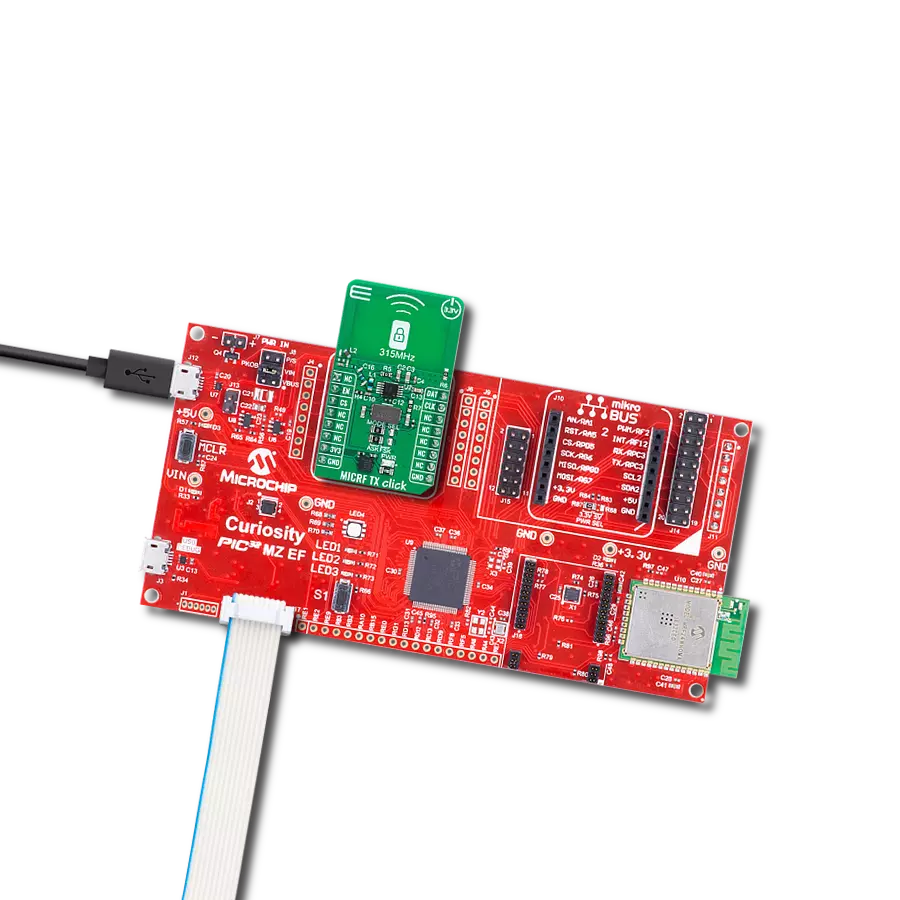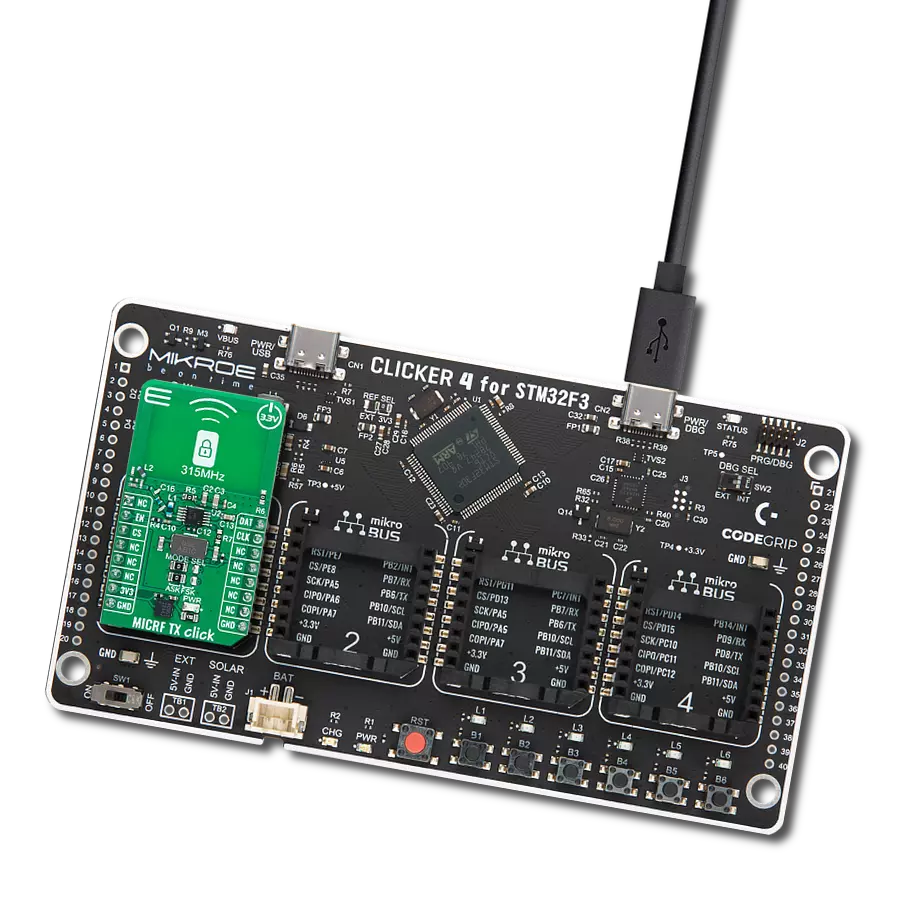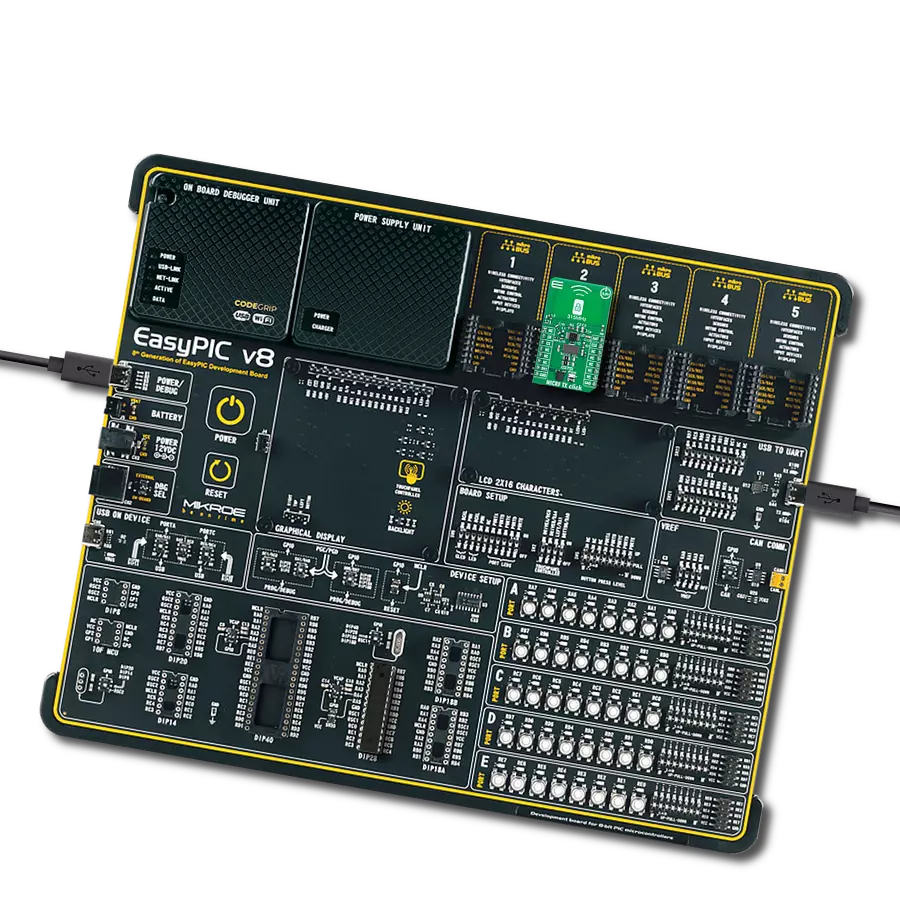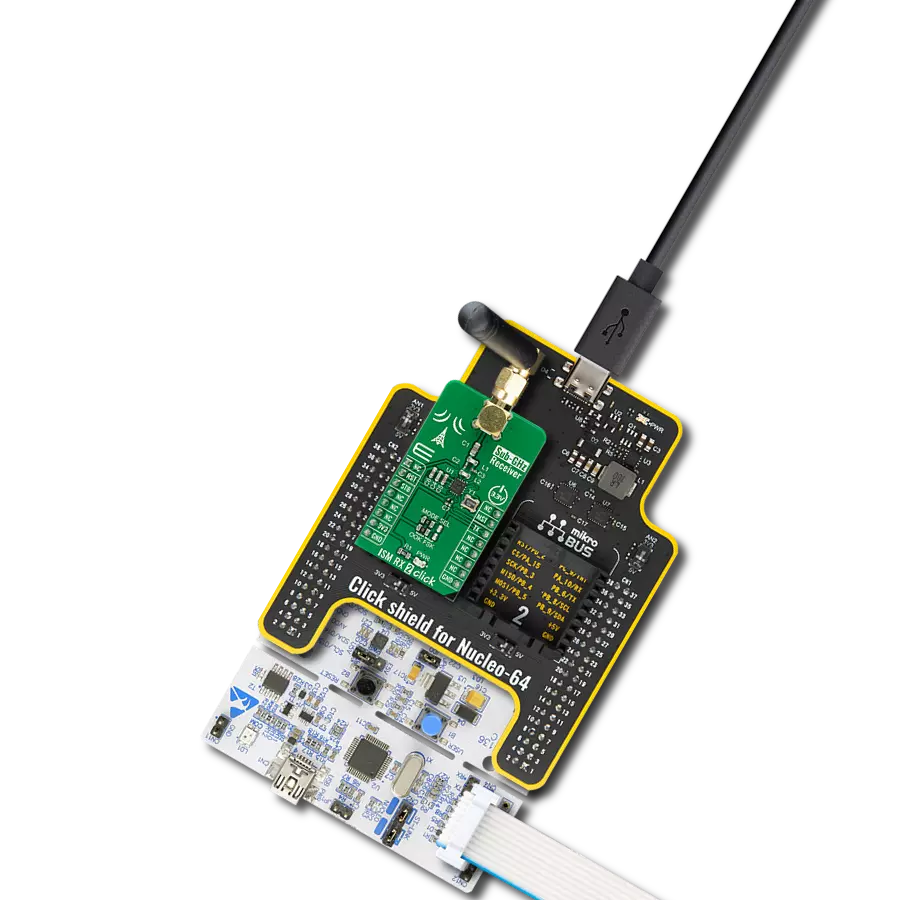Ensure seamless connectivity between smart-grid devices
A
A
Hardware Overview
How does it work?
Wireless SUN Click is based on the BP35C5, an ultra-compact Wi-SUN FAN-compatible wireless communication module from Rohm Semiconductor. The BP35C5 has been certified by the Radio Law of ARIB and FCC, so it can be used in Japan and the United States operating at the frequency of 920MHz with a binary GFSK modulation method. It also includes a Wi-SUN software stack that enables operation at different transmission modes (20, 10, or 1mW) for high efficiency. In addition, since it has a built-in security function and supports communication encryption and security key update on the module side, it can perform secure communication efficiently without complicated control. As mentioned before, this module uses the Wi-SUN FAN (Field Area Network) mesh networking protocol, consisting of a parent repeater called Border Router, a repeater called Router,
and a terminal called Leaf. It can cover a wide range because of its relay function (hopping function). That's why it is possible to build a mesh network of up to 1000 units - multi-hop mesh networks supporting channel hopping with the ability to avoid radio interference by automatic routing (ability to switch routes automatically). This feature makes it suitable for social infrastructure applications such as traffic and street lights, building a remote management system that covers the entire city. This Click board™ communicates with MCU using the UART interface with commonly used UART RX, TX, and hardware flow control pins UART CTS and RTS (Clear to Send and Ready to Send). It operates at 115200 bps by default to transmit and exchange data with the host MCU. Besides, additional onboard test points TP1 and TP2 offer users full support of debugging and programming
capabilities through a Serial Wire Debug interface for programming and debugging, available through the SWD interface pins (SWCK and SWD). In addition to the appropriate interfaces, this Click board™ also has some additional features. A Reset button routed to the RST pin on the mikroBUS™ socket puts the module into a Reset state, while a blue LED indicator labeled STATUS represents a broadcast transmitting status LED indicator. This Click board™ can only be operated with a 3.3V logic voltage level. The board must perform appropriate logic voltage level conversion before using MCUs with different logic levels. However, the Click board™ comes equipped with a library containing functions and an example code that can be used as a reference for further development.

Features overview
Development board
Nucleo-64 with STM32F091RC MCU offers a cost-effective and adaptable platform for developers to explore new ideas and prototype their designs. This board harnesses the versatility of the STM32 microcontroller, enabling users to select the optimal balance of performance and power consumption for their projects. It accommodates the STM32 microcontroller in the LQFP64 package and includes essential components such as a user LED, which doubles as an ARDUINO® signal, alongside user and reset push-buttons, and a 32.768kHz crystal oscillator for precise timing operations. Designed with expansion and flexibility in mind, the Nucleo-64 board features an ARDUINO® Uno V3 expansion connector and ST morpho extension pin
headers, granting complete access to the STM32's I/Os for comprehensive project integration. Power supply options are adaptable, supporting ST-LINK USB VBUS or external power sources, ensuring adaptability in various development environments. The board also has an on-board ST-LINK debugger/programmer with USB re-enumeration capability, simplifying the programming and debugging process. Moreover, the board is designed to simplify advanced development with its external SMPS for efficient Vcore logic supply, support for USB Device full speed or USB SNK/UFP full speed, and built-in cryptographic features, enhancing both the power efficiency and security of projects. Additional connectivity is
provided through dedicated connectors for external SMPS experimentation, a USB connector for the ST-LINK, and a MIPI® debug connector, expanding the possibilities for hardware interfacing and experimentation. Developers will find extensive support through comprehensive free software libraries and examples, courtesy of the STM32Cube MCU Package. This, combined with compatibility with a wide array of Integrated Development Environments (IDEs), including IAR Embedded Workbench®, MDK-ARM, and STM32CubeIDE, ensures a smooth and efficient development experience, allowing users to fully leverage the capabilities of the Nucleo-64 board in their projects.
Microcontroller Overview
MCU Card / MCU
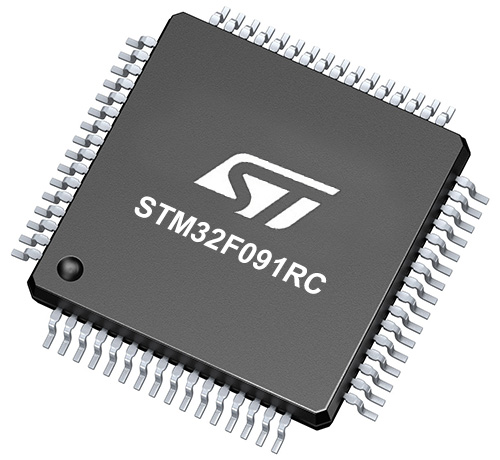
Architecture
ARM Cortex-M0
MCU Memory (KB)
256
Silicon Vendor
STMicroelectronics
Pin count
64
RAM (Bytes)
32768
You complete me!
Accessories
Click Shield for Nucleo-64 comes equipped with two proprietary mikroBUS™ sockets, allowing all the Click board™ devices to be interfaced with the STM32 Nucleo-64 board with no effort. This way, Mikroe allows its users to add any functionality from our ever-growing range of Click boards™, such as WiFi, GSM, GPS, Bluetooth, ZigBee, environmental sensors, LEDs, speech recognition, motor control, movement sensors, and many more. More than 1537 Click boards™, which can be stacked and integrated, are at your disposal. The STM32 Nucleo-64 boards are based on the microcontrollers in 64-pin packages, a 32-bit MCU with an ARM Cortex M4 processor operating at 84MHz, 512Kb Flash, and 96KB SRAM, divided into two regions where the top section represents the ST-Link/V2 debugger and programmer while the bottom section of the board is an actual development board. These boards are controlled and powered conveniently through a USB connection to program and efficiently debug the Nucleo-64 board out of the box, with an additional USB cable connected to the USB mini port on the board. Most of the STM32 microcontroller pins are brought to the IO pins on the left and right edge of the board, which are then connected to two existing mikroBUS™ sockets. This Click Shield also has several switches that perform functions such as selecting the logic levels of analog signals on mikroBUS™ sockets and selecting logic voltage levels of the mikroBUS™ sockets themselves. Besides, the user is offered the possibility of using any Click board™ with the help of existing bidirectional level-shifting voltage translators, regardless of whether the Click board™ operates at a 3.3V or 5V logic voltage level. Once you connect the STM32 Nucleo-64 board with our Click Shield for Nucleo-64, you can access hundreds of Click boards™, working with 3.3V or 5V logic voltage levels.
868MHz right-angle rubber antenna is a compact and versatile solution for wireless communication. Operating within the frequency range of 868-915MHz, it ensures optimal signal reception and transmission. With a 50-ohm impedance, it's compatible with various devices and systems. This antenna boasts a 2dB gain, enhancing signal strength and extending communication range. Its vertical polarization further contributes to signal clarity. Designed to handle up to 50W of input power, it's a robust choice for various applications. Measuring just 48mm in length, this antenna is both discreet and practical. Its SMA male connector ensures a secure and reliable connection to your equipment. Whether you're working with IoT devices, remote sensors, or other wireless technologies, the 868MHz right-angle antenna offers the performance and flexibility you need for seamless communication.
Used MCU Pins
mikroBUS™ mapper
Take a closer look
Click board™ Schematic

Step by step
Project assembly
Track your results in real time
Application Output
1. Application Output - In Debug mode, the 'Application Output' window enables real-time data monitoring, offering direct insight into execution results. Ensure proper data display by configuring the environment correctly using the provided tutorial.

2. UART Terminal - Use the UART Terminal to monitor data transmission via a USB to UART converter, allowing direct communication between the Click board™ and your development system. Configure the baud rate and other serial settings according to your project's requirements to ensure proper functionality. For step-by-step setup instructions, refer to the provided tutorial.

3. Plot Output - The Plot feature offers a powerful way to visualize real-time sensor data, enabling trend analysis, debugging, and comparison of multiple data points. To set it up correctly, follow the provided tutorial, which includes a step-by-step example of using the Plot feature to display Click board™ readings. To use the Plot feature in your code, use the function: plot(*insert_graph_name*, variable_name);. This is a general format, and it is up to the user to replace 'insert_graph_name' with the actual graph name and 'variable_name' with the parameter to be displayed.

Software Support
Library Description
This library contains API for Wireless SUN Click driver.
Key functions:
wirelesssun_send_cmdThis function sends a specified command to the click module.wirelesssun_send_cmd_with_parameterThis function sends a specified command to the click module with desired parameters appended to.wirelesssun_generic_readThis function reads a desired number of data bytes by using UART serial interface.
Open Source
Code example
The complete application code and a ready-to-use project are available through the NECTO Studio Package Manager for direct installation in the NECTO Studio. The application code can also be found on the MIKROE GitHub account.
/*!
* @file main.c
* @brief Wireless SUN Click Example.
*
* # Description
* This example demonstrates the use of Wireless SUN Click board by showing
* the communication between the two Click boards configured as BORDER and ROUTER.
*
* The demo application is composed of two sections :
*
* ## Application Init
* Initializes the driver and configures the Click board by performing a hardware reset
* and a clear parameters feature, and setting the device network name, device role to
* BORDER or ROUTER depending on the application mode. In the end, it saves settings and
* reboots device.
*
* ## Application Task
* Depending on the selected application mode, it reads all the received data and parses
* the received TCP/UDP messages (BORDER mode) or waits for the connection, reads the parent
* global address, and then starts sending a desired TCP/UDP messages to the parent every
* 3 seconds (ROUTER mode).
*
* ## Additional Function
* - static void wirelesssun_clear_app_buf ( void )
* - static err_t wirelesssun_process ( void )
* - static err_t wirelesssun_rsp_check ( void )
* - static void wirelesssun_wait_for_connection ( void )
* - static void wirelesssun_get_parent_gbl_address ( uint8_t *gbl_addr )
*
* @note
* By default, the BORDER application mode is selected. comment out the DEMO_APP_BORDER macro
* definition in order to switch the application mode to ROUTER.
*
* @author Stefan Filipovic
*
*/
#include "board.h"
#include "log.h"
#include "wirelesssun.h"
#include "conversions.h"
// Comment out the line below in order to switch the application mode to ROUTER
#define DEMO_APP_BORDER
// Device network name.
#define DEVICE_NETWORK_NAME "\"Wireless SUN Click\""
// Text message to send in the transmitter application mode
#define DEMO_TEXT_MESSAGE "MikroE - Wireless SUN Click board"
#define PROCESS_BUFFER_SIZE 600
static wirelesssun_t wirelesssun;
static log_t logger;
static char app_buf[ PROCESS_BUFFER_SIZE ] = { 0 };
static int32_t app_buf_len = 0;
static int32_t app_buf_cnt = 0;
/**
* @brief Wireless SUN clearing application buffer.
* @details This function clears memory of application buffer and reset its length and counter.
* @return None.
* @note None.
*/
static void wirelesssun_clear_app_buf ( void );
/**
* @brief Wireless SUN data reading function.
* @details This function reads data from device and concatenates data to application buffer.
* @return @li @c 0 - Read some data.
* @li @c -1 - Nothing is read.
* See #err_t definition for detailed explanation.
* @note None.
*/
static err_t wirelesssun_process ( void );
/**
* @brief Response check.
* @details This function checks for response and
* returns the status of response.
* @return @li @c 0 - OK response.
* @li @c -1 - Nothing is read.
* @li @c -2 - Timeout error.
* See #err_t definition for detailed explanation.
* @note None.
*/
static err_t wirelesssun_rsp_check ( void );
/**
* @brief Wireless SUN wait for connection function.
* @details This function waits for the ROUTER connection - FAN join state 5(OPERATIONAL).
* @return None.
* @note None.
*/
static void wirelesssun_wait_for_connection ( void );
/**
* @brief Wireless SUN get parent gbl address function.
* @details This function reads the parent global address after the ROUTER connects to the BORDER.
* @return None.
* @note None.
*/
static void wirelesssun_get_parent_gbl_address ( uint8_t *gbl_addr );
void application_init ( void )
{
log_cfg_t log_cfg; /**< Logger config object. */
wirelesssun_cfg_t wirelesssun_cfg; /**< Click config object. */
/**
* Logger initialization.
* Default baud rate: 115200
* Default log level: LOG_LEVEL_DEBUG
* @note If USB_UART_RX and USB_UART_TX
* are defined as HAL_PIN_NC, you will
* need to define them manually for log to work.
* See @b LOG_MAP_USB_UART macro definition for detailed explanation.
*/
LOG_MAP_USB_UART( log_cfg );
log_init( &logger, &log_cfg );
log_info( &logger, " Application Init " );
// Click initialization.
wirelesssun_cfg_setup( &wirelesssun_cfg );
WIRELESSSUN_MAP_MIKROBUS( wirelesssun_cfg, MIKROBUS_1 );
if ( UART_ERROR == wirelesssun_init( &wirelesssun, &wirelesssun_cfg ) )
{
log_error( &logger, " Communication init." );
for ( ; ; );
}
app_buf_len = 0;
app_buf_cnt = 0;
log_printf( &logger, "\r\n - Reset device -\r\n" );
wirelesssun_reset_device ( &wirelesssun );
wirelesssun_rsp_check ( );
log_printf( &logger, "\r\n - Clear parameters and reboot device -\r\n" );
wirelesssun_send_cmd ( &wirelesssun, WIRELESSSUN_CMD_CLRST );
wirelesssun_rsp_check ( );
log_printf( &logger, "\r\n - Set device name -\r\n" );
wirelesssun_send_cmd_with_parameter ( &wirelesssun, WIRELESSSUN_CMD_NETNAME, DEVICE_NETWORK_NAME );
wirelesssun_rsp_check ( );
log_printf( &logger, "\r\n - Set device starting role -\r\n" );
#ifdef DEMO_APP_BORDER
wirelesssun_send_cmd_with_parameter ( &wirelesssun, WIRELESSSUN_CMD_ATSTART, WIRELESSSUN_DEVICE_ROLE_BORDER );
#else
wirelesssun_send_cmd_with_parameter ( &wirelesssun, WIRELESSSUN_CMD_ATSTART, WIRELESSSUN_DEVICE_ROLE_ROUTER );
#endif
wirelesssun_rsp_check ( );
log_printf( &logger, "\r\n - Save settings and reboot device -\r\n" );
wirelesssun_send_cmd ( &wirelesssun, WIRELESSSUN_CMD_SVRST );
wirelesssun_rsp_check ( );
log_info( &logger, " Application Task " );
}
void application_task ( void )
{
#ifdef DEMO_APP_BORDER
wirelesssun_process( );
if ( strstr( app_buf, WIRELESSSUN_CMD_PROMPT_SIGN ) )
{
uint8_t demo_hex_msg[ 100 ] = { 0 };
uint8_t demo_text_msg[ 50 ] = { 0 };
char * __generic_ptr start_msg_ptr = NULL;
char * __generic_ptr end_msg_ptr = NULL;
uint8_t msg_len = 0;
uint8_t msg_cnt = 0;
if ( ( strstr( app_buf, WIRELESSSUN_RSP_TCPR ) ) || ( strstr( app_buf, WIRELESSSUN_RSP_UDPR ) ) )
{
if ( strstr( app_buf, WIRELESSSUN_RSP_TCPR ) )
{
start_msg_ptr = strstr( app_buf, WIRELESSSUN_RSP_TCPR );
}
else
{
start_msg_ptr = strstr( app_buf, WIRELESSSUN_RSP_UDPR );
}
start_msg_ptr = strstr ( start_msg_ptr, ">" ) + 2;
end_msg_ptr = strstr( start_msg_ptr, WIRELESSSUN_CMD_PROMPT_SIGN );
msg_len = ( end_msg_ptr - start_msg_ptr );
memcpy ( demo_hex_msg, start_msg_ptr, msg_len );
for ( msg_cnt = 0; msg_cnt < msg_len; msg_cnt += 2 )
{
demo_text_msg[ msg_cnt / 2 ] = hex_to_uint8 ( &demo_hex_msg [ msg_cnt ] );
}
if ( strstr( app_buf, WIRELESSSUN_RSP_TCPR ) )
{
log_printf( &logger, "\r\n - Received TCP message: \"%s\" -\r\n", demo_text_msg );
}
else
{
log_printf( &logger, "\r\n - Received UDP message: \"%s\" -\r\n", demo_text_msg );
}
}
wirelesssun_clear_app_buf( );
}
#else
wirelesssun_wait_for_connection ( );
uint8_t gbl_address[ 20 ] = { 0 };
wirelesssun_get_parent_gbl_address ( gbl_address );
for ( ; ; )
{
uint8_t tcp_udp_params[ 120 ] = { 0 };
uint8_t demo_hex_msg[ 100 ] = { 0 };
uint8_t demo_text_msg[ 50 ] = { 0 };
uint8_t msg_cnt = 0;
strcpy ( demo_text_msg, DEMO_TEXT_MESSAGE );
strcpy ( tcp_udp_params, gbl_address );
strcat ( tcp_udp_params, WIRELESSSUN_CMD_DELIMITER );
strcat ( tcp_udp_params, WIRELESSSUN_DEFAULT_PORT );
strcat ( tcp_udp_params, WIRELESSSUN_CMD_DELIMITER );
for ( msg_cnt = 0; msg_cnt < strlen ( demo_text_msg ); msg_cnt++ )
{
uint8_to_hex ( demo_text_msg[ msg_cnt ], &demo_hex_msg[ msg_cnt * 2 ] );
}
strcat ( tcp_udp_params, demo_hex_msg );
log_printf( &logger, "\r\n - Sending \"%s\" message via TCP -\r\n", demo_text_msg );
wirelesssun_send_cmd_with_parameter ( &wirelesssun, WIRELESSSUN_CMD_TCPS, tcp_udp_params );
wirelesssun_rsp_check ( );
Delay_ms ( 1000 );
Delay_ms ( 1000 );
Delay_ms ( 1000 );
log_printf( &logger, "\r\n - Sending \"%s\" message via UDP -\r\n", demo_text_msg );
wirelesssun_send_cmd_with_parameter ( &wirelesssun, WIRELESSSUN_CMD_UDPS, tcp_udp_params );
wirelesssun_rsp_check ( );
Delay_ms ( 1000 );
Delay_ms ( 1000 );
Delay_ms ( 1000 );
}
#endif
}
int main ( void )
{
/* Do not remove this line or clock might not be set correctly. */
#ifdef PREINIT_SUPPORTED
preinit();
#endif
application_init( );
for ( ; ; )
{
application_task( );
}
return 0;
}
static void wirelesssun_clear_app_buf ( void )
{
memset( app_buf, 0, app_buf_len );
app_buf_len = 0;
app_buf_cnt = 0;
}
static err_t wirelesssun_process ( void )
{
int32_t rx_size;
char rx_buf[ PROCESS_BUFFER_SIZE ] = { 0 };
rx_size = wirelesssun_generic_read( &wirelesssun, rx_buf, PROCESS_BUFFER_SIZE );
if ( rx_size > 0 )
{
int32_t buf_cnt = 0;
if ( ( app_buf_len + rx_size ) > PROCESS_BUFFER_SIZE )
{
wirelesssun_clear_app_buf( );
log_error( &logger, " Overflow!" );
return WIRELESSSUN_ERROR;
}
else
{
buf_cnt = app_buf_len;
app_buf_len += rx_size;
}
for ( int32_t rx_cnt = 0; rx_cnt < rx_size; rx_cnt++ )
{
if ( rx_buf[ rx_cnt ] )
{
app_buf[ ( buf_cnt + rx_cnt ) ] = rx_buf[ rx_cnt ];
log_printf( &logger, "%c", rx_buf[ rx_cnt ] );
}
else
{
app_buf_len--;
buf_cnt--;
}
}
return WIRELESSSUN_OK;
}
return WIRELESSSUN_ERROR;
}
static err_t wirelesssun_rsp_check ( void )
{
uint32_t timeout_cnt = 0;
uint32_t timeout = 120000;
wirelesssun_clear_app_buf( );
wirelesssun_process( );
while ( 0 == strstr( app_buf, WIRELESSSUN_CMD_PROMPT_SIGN ) )
{
wirelesssun_process( );
if ( timeout_cnt++ >= timeout )
{
wirelesssun_clear_app_buf( );
log_error( &logger, " Timeout!" );
return WIRELESSSUN_ERROR_TIMEOUT;
}
Delay_ms ( 1 );
}
log_printf( &logger, "\r\n" );
return WIRELESSSUN_OK;
}
static void wirelesssun_wait_for_connection ( void )
{
#define FSTAT_OPERATIONAL "fstat 5(OPERATIONAL)"
#define FMNG_JOIN_STATE_5 "FMng: changed fan join state (4 -> 5)"
uint32_t timeout_cnt = 0;
uint32_t timeout = 60000;
for ( ; ; )
{
wirelesssun_process( );
if ( timeout_cnt++ >= timeout )
{
wirelesssun_send_cmd ( &wirelesssun, WIRELESSSUN_CMD_FSTAT );
wirelesssun_rsp_check ( );
timeout_cnt = 0;
}
Delay_ms ( 1 );
if ( ( strstr( app_buf, FMNG_JOIN_STATE_5 ) ) ||
( strstr( app_buf, FSTAT_OPERATIONAL ) ) )
{
wirelesssun_clear_app_buf( );
return;
}
if ( strstr( app_buf, WIRELESSSUN_CMD_PROMPT_SIGN ) )
{
wirelesssun_clear_app_buf( );
}
}
}
static void wirelesssun_get_parent_gbl_address ( uint8_t *gbl_addr )
{
#define GBL_ADDRESS_START "GBL<"
#define GBL_ADDRESS_END ">"
for ( ; ; )
{
uint16_t timeout_cnt = 0;
uint16_t timeout = 10000;
wirelesssun_send_cmd ( &wirelesssun, WIRELESSSUN_CMD_RPLINF );
wirelesssun_rsp_check ( );
for ( ; ; )
{
wirelesssun_process( );
if ( strstr( app_buf, WIRELESSSUN_CMD_PROMPT_SIGN ) )
{
char * __generic_ptr start_gbl_ptr = strstr( app_buf, GBL_ADDRESS_START );
if ( start_gbl_ptr )
{
start_gbl_ptr += 4;
Delay_ms ( 100 );
wirelesssun_process( );
char * __generic_ptr end_gbl_ptr = strstr( start_gbl_ptr, GBL_ADDRESS_END );
memcpy ( gbl_addr, start_gbl_ptr, end_gbl_ptr - start_gbl_ptr );
wirelesssun_clear_app_buf( );
return;
}
wirelesssun_clear_app_buf( );
}
if ( timeout_cnt++ > timeout )
{
break;
}
Delay_ms ( 1 );
}
}
}
// ------------------------------------------------------------------------ END
Additional Support
Resources
Category:Sub-1 GHz Transceievers



















